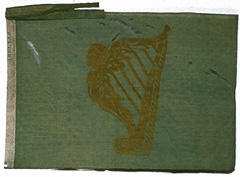 |
Clan
Henebry
Association
TM
Henebry/Henneberry Families from the Irish counties of |
| Home | Site Map | Message Board | Contact Us | Clan Henebry |
Online Since March 1995 |
|
Cushing Family in Civil War from IllinoisSource: Illinois State Archives |
 |
23rd Illinois Infantry National Flag
The 23rd Illinois Infantry was also known as the Irish Brigade or the 1st Irish Regiment. The Regimental guidon or flank marker reflects this Irish influence. This color measures approximately 30" x 20". |
Source: Civil War Flags:
Flag Description: 23rd Illinois
Infantry National Flag
There were no battle honors on this flag. The men of this
Regiment were from: Company A- Wayne County (formerly the Detroit Jackson
Guards); Company B-Cook County (formerly the Montgomery Guards); Company C-Cook
County (formerly the Chicago Jackson Guards); Company D-LaSalle County (formerly
the Earlville Guards or Earlville Rifles); Company E-Grundy County, Morris
(formerly the Ottawa Guards) ; Company F-LaSalle County (formerly the Douglas
Guards or LaSalle Guards); Company G-Cook County (formerly the O'Mahoney
Rifles); Company H-Ottawa (formerly the Ottawa City Guards); Company I-Cook
County (Shields Guards "A"); Company K-Cook County (Shields Guards
"B"). There is a good article on the history of this Regiment entitled
"The Western Irish Brigade" in "The Irish Sword-the Journal of
the Military History Society of Ireland" by Frederic Von Allendorfer, Vol
II:No. 7, Winter, 1955, pp176-83. The Regiment was given one battle honor-for
the battle of Lexington but the battle honor is not on this flag.
Flag Description: 23rd Illinois
Infantry Regimental Flag
"Major Moore was sent to General Price under a flag of
truce. Price would accept only unconditional surrender--the officers to be
retained as prisoners of war and the men to be paroled after surrendering their
arms and accoutrements. Amongst the men of the 23rd that night the Regimental
flag was torn into shreds. Each received a small green patch, thus saving the
flag from being taken as a trophy of war by the enemy. At 4 o'clock on the
afternoon of the 21st the Union forces under Colonel Mulligan marched out of the
defenses taking with them only their personal effects. The officers were held as
prisoners in Lexington and the 1,500 men were taken across the Missouri River
and were released on the 22nd to find their way home as best they could."
Von Allendorfer, Frederic. "The Western Irish Brigade" in The Irish
Sword, Vol II, No. 7 (Winter, 1955) p181.
Source: Illinois State Archives
23rd Illinois Infantry
The organization of the TWENTY-THIRD INFANTRY ILLINOIS VOLUNTEERS commenced under the popular name of the "Irish Brigade", at Chicago, immediately upon the opening of hostilities at Sumter. It served until the war had fully closed, and among the officers whom it compelled to mourn as lost in battle was its illustrious Colonel, James A. Mulligan, of Chicago, who fell while commanding a division of the Army of West Virginia at Kernstown, in Shenandoah Valley, July 24, 1864, and perished while in the hands of the enemy, July 26, of three desperate wounds, received while at head of his own Regiment to which he had galloped in the confident and justified expectation that he would be able to make it the steady rear-guard of an overwhelming rout, caused by the advance of all of Early’s army upon an unsupported and meager force.
The formal muster of the 23d was made June 15, 1861, at Chicago when the Regiment was occupying barracks known as Kane’s brewery on West Polk street, near the river. From a barrack encampment, to the arsenal at St. Louis. On the 21st of July it moved to Jefferson City, at a time when Colonel Jeff. C. Davis was in command of the post. During the month of August it made various excursions into the surrounding country, Brigadier General Grant superseded Colonel Davis as commander of the post at Jefferson City, and on the 18th of September the 23d commenced a march of 120 miles on Lexington, Mo., where the first notable siege of the war of the rebellion occurred. Lexington, reinforced by the 23d, which arrived on the evening of the 11th, became a post of 2,780 men, Colonel Mulligan commanding. General Price with the Missouri State guard was marching upon the town, a convenient location near which Colonel Mulligan’s command engaged actively in fortifying. The rebel advance under Raines with a battery of six guns assaulted the fortifications on the 12th but were repulsed. The post was then regularly invested by an army of 28,000 men with 13 pieces of artillery. For nine days the garrison sustained an unequal conflict, not alone against the vastly superior forces of the enemy but against hunger and thirst, for provisions, hastily gathered in from the surrounding country, were inadequate and the water supply wholly failed. No reinforcement appeared, nor was there promise or hope of any. On the 20th the most determined and systematic of the enemy’s assaults was made, and repeatedly repulsed, but in the afternoon it was determined to surrender. The killed and wounded of the Regiment numbered 107, while General Price officially report his loss at 800.
The officers and men, with the exception of Colonel Mulligan, who was detained as a prisoner and accompanied Price in his march into Arkansas, were paroled. On the 8th of October the Regiment was mustered out by order of General Fremont, but upon the personal application of Colonel Mulligan, who had been exchanged for General Frost, General McClellan, then commanding the army, directed that its organization be retained and that it should be considered as continuously in the service from the date of its original muster. Reassembling at Camp Douglas in Chicago, the camp being commanded by Colonel Mulligan, it guarded rebel prisoners there until June 14, 1862, when it was ordered to Harper’s Ferry, Virginia. Its service thenceforward was in both Virginias. From Harper’s Ferry it moved to New Creek, Virginia. It was at Clarksburg, Virginia, in September and later at Parkersburg, in both cases saving the towns from the menace of Imboden. November 10, 1862, companies B, D and K under Major Moore attacked Gen. Imboden on the South Fork of the Potomac, capturing forty prisoners and large supplies on the hoof. January 3, 1863, the Regiment made a forced march of 40 miles in 10 hours from New Creek to Moorefield to the relief of the Union force there attacked by Gen. Jones, who thereupon withdrew. in April 1863, being then at New Creek, the Regiment as assigned to the 5th Brigade, 1st Division, 8th Corps, Colonel Mulligan commanding the Brigade and Lieutenant Colonel Quirk the Regiment.
The Regiment moved to Grafton on the 25th of April, and Captain Martin Wallace, commanding Co. G, as a detachment in Greenland Gap, occupying a block house, had a spirited engagement with General Jones did not surrender until the block house was in flames. April 25th the Regiment was engaged with Imboden at Phillippi. In 1863 the Regiment was on the flank of Lee in his retreat from Gettysburg, and had an engagement with Wade Hampton at Hedgeville. Having re-enlisted as veterans at New Creek in April 1864, the Regiment was reorganized at Chicago and the month’s furlough having expired returned to Virginia.
During the month of July 1864, the Regiment participated in the following engagements: 3d, Leetown, Va.; 5th to 7th, Maryland Heights, Md.; 17th to 20th, Snicker’s Gap, Va.; 23d and 24th, Kernstown, Va., where Colonel Mulligan was killed. In the battle of Kernstown on the 24th, the Regiment lost in killed and wounded about one-half of those engaged therein.
From early in August 1864, to December 25, 1864, during which time General Sheridan was in command of the Shenandoah Valley, the Regiment was actively engaged therein, and took part in the following battles and skirmishes: Cedar Creek, August 12th to 16th; Winchester, August 17th; Charleston and Halltown, August 21st to 28th; Berryville, Sept. 3d; Opequan Creek, Sept. 19th; Fisher’s Hill, Sept. 21st and 22d; Harrisonburg, Oct. --; Cedar Creek, October 13th; Cedar Creek,
October 19th. About December 30th, 1864, the Regiment was transferred to Army of the James, and during January 1865, was in front of Richmond, and was afterward assigned to the defenses of Bermuda Hundreds. March 25, 1865, rejoined Twenty-fourth Army Corps north of the James River, and thence moved to the left as far as Hatcher’s Run, where was engaged March 31st and April 1st, and on April 2d assisted in the assault and capture of Fort Gregg in front of Petersburg, and thereafter took park in the pursuit of Lee’s Army until the surrender thereof at Appomattox C.H., April 9, 1865.
In the months of January and February 1864, while stationed at Greenland Gap, W.Va., First Lieutenant John J. Healy, as special recruiting officer, re-enlisted about 300 of the Regiment as veterans, and in May following they came to Chicago on thirty days furlough, as the Twenty-third
Regiment Illinois Veteran Volunteers.
In August 1864, the 10 companies of the Regiment, then numbering 440, were consolidated into five companies, and was designated "Battalion Twenty-Third Regiment Illinois Veteran Volunteer Infantry", and Lieutenant Colonel Simison assigned to command. In March 1865, Colonel Simison returned to Illinois, leaving Captain P. M. Ryan in command, to have five new companies assigned by the Governor to fill the Regiment, and in this he was successful, but the new companies did not meet the Veterans until the surrender of Lee. The Regiment was thanked by Congress for its part at Lexington, and was authorized to inscribe Lexington upon its colors. Two medals authorized by Congress, were given members of the command for gallant conduct. They were bestowed upon Private Craig, Company C, who, at the battle of Fisher’s Hill, knocked down a rebel color-bearer and captured his flag, and Private Patrick Hyland, Company D, who was the first soldier to scale the rebel works at Fort Gregg, Petersburg, April 2, 1865. The orders for consolidation after the death of Colonel Mulligan, are not appended. Lieutenant Colonel Quirk and Major Moore retired after the veteran re-organization.
Irish Dragoons
No official history is found in the Report of the Adjutant General of Illinois for this unit. This Company was organized in Missouri under authority of General Fremont, to be attached to the Twenty-third Illinois Infantry (Irish Brigade) as a Cavalry company. The officers were commissioned by the Governor of Illinois. The Company was not attached to the Irish Brigade, but, against the protest of its members, was assigned as Company L to the Third Missouri Cavalry. On account of the difficulties and animosities engendered by this transfer, the Company was subsequently assigned as Company L to the Fifth Iowa Cavalry.
|
Copyright 1990-2007: RMK
Research. All rights reserved. You may link to this
site, but NO photos or information may be copied without prior written
permission. Any infringement will be subject to legal action. Website
hosted and designed by Ronald M. Knowles, member:
Moultrie County Historical &
Genealogical Society.
Disclaimer
Site sponsored by:
SMOGCHECK.COMô and
SmogTestOnly and
TestOnlySmogCheck
and
OrangeCountySmogCheck.Biz
and AnaheimSmog.Biz and
CostaMesaSmog.Biz and
SantaAnaSmog.Biz and
WestminsterSmogCheck.Biz
and OCSmogCheck.Biz and
Garden Grove Smog Check and
Mainstreet Smogcheck and
SmogTest.Biz and
Huntington Beach Smog Biz and
Smog Check California and
Smog Test California |